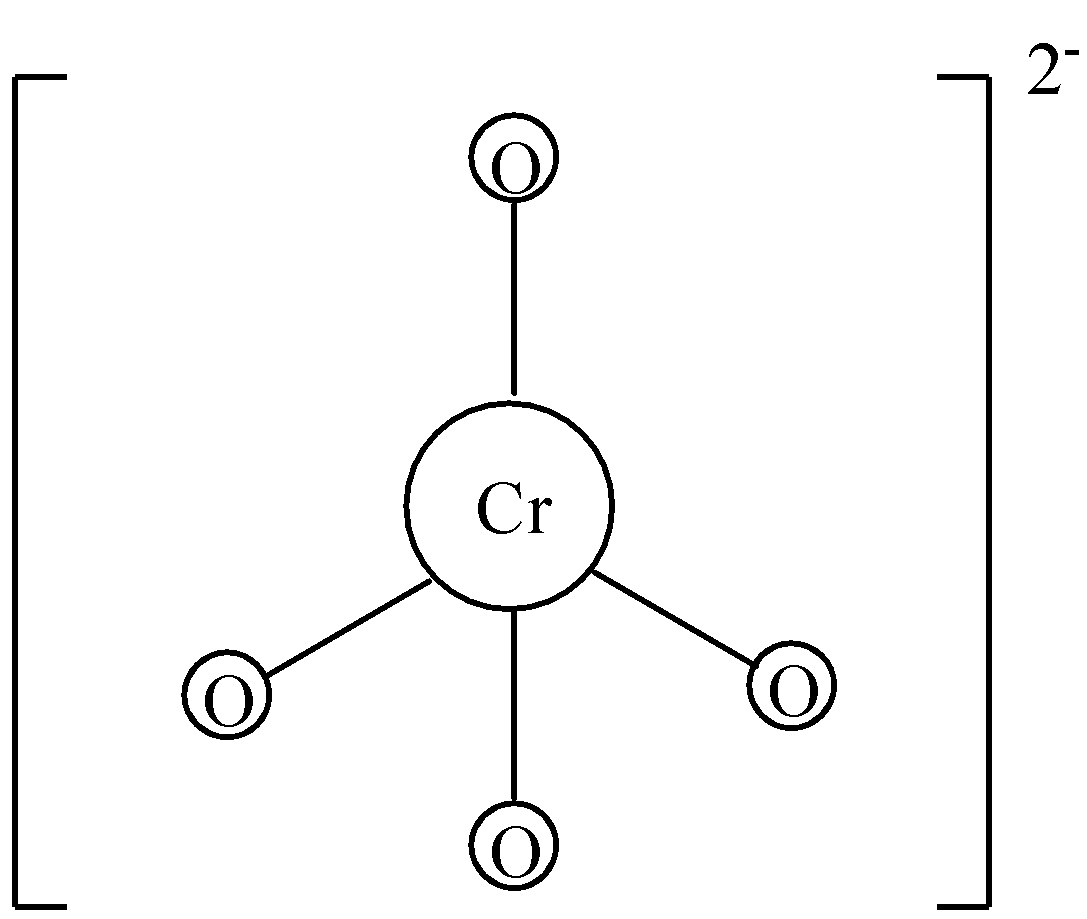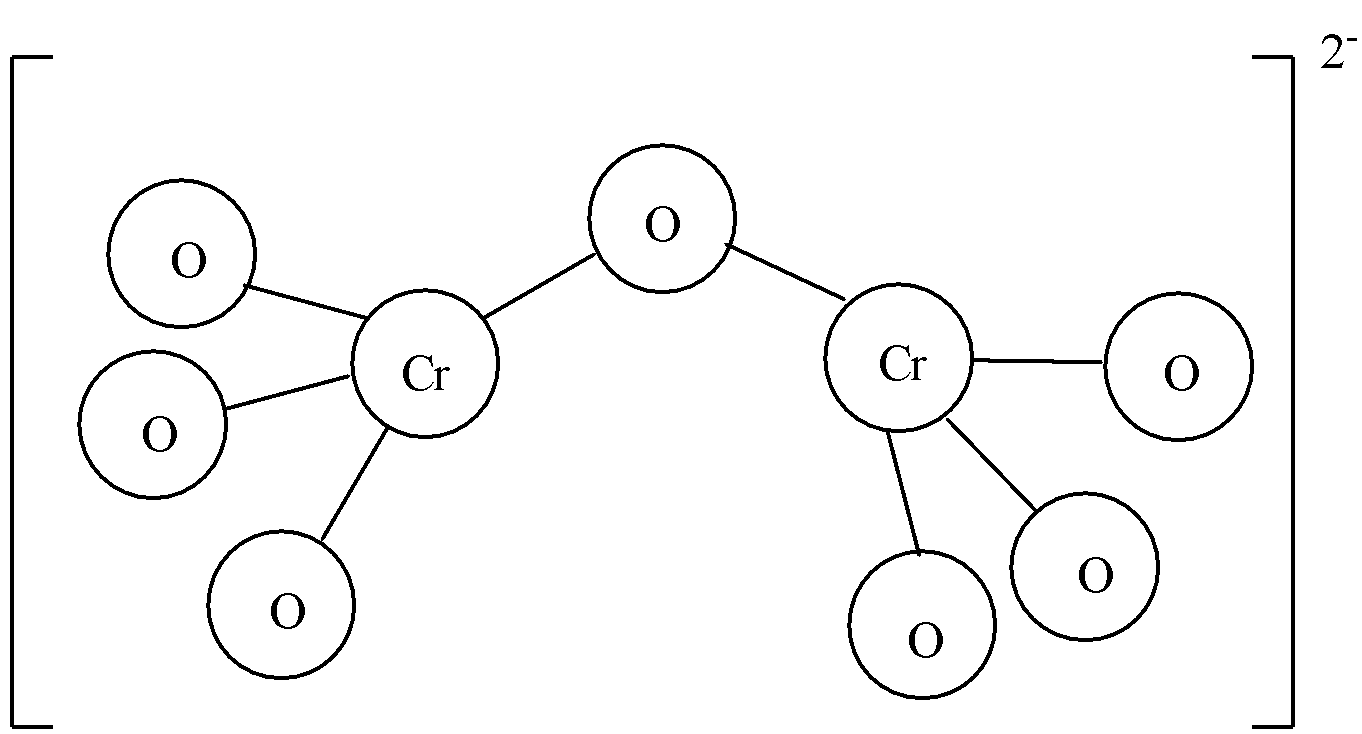
The ionic charges on chromate ion and dichromate ion respectively are:
(a)-2, -2
(b)-3, -2
(c)-2, -4
(d)-4, -2
Answer
581.7k+ views
Hint: Ionic charge is the charge on an ion. Ionic charge is due to the gain or loss of one or more electrons from an atom or a group of atoms.
Complete answer:
As mentioned above, ionic charge is the charge on an ion. Let us discuss the two ions mentioned in the question.
-Chromate ion or chromate anion is present in chromate salts. When chromate salt dissociates, we get chromate ions. It consists of one chromium and four oxygen atoms. It is written as $CrO_{4}^{2-}$. The charge on the chromate ion is -2. The oxidation state of chromium in chromate ion is +6 and the oxidation state of oxygen is -2. There are four oxygen atoms, so we have to multiply -2 with four to get -8. By adding the oxidation state of chromium and total oxidation state of oxygen, we get -2. So, the ionic charge on chromate ions is -2.

-Dichromate ions are obtained from dissociation of dichromate salts. As the name suggests, there are two chromium atoms in dichromate ion. Dichromate is also an anion. It has an ionic charge of -2. We know that the oxidation state of chromium is +6 in dichromate. There are two chromium atoms, so we need to multiply +6 with two, we get +12. Dichromate anion consists of seven oxygen atoms and oxidation state of oxygen is -2. Multiplying seven with -2 we get -14. Adding the total oxidation state of chromium and oxygen, we get -2. So, the ionic charge on dichromate ions is -2.

Thus, both chromate ion and dichromate ion have ionic charge -2. The correct answer to the question is option (a).
Note: In chromate ion and dichromate ion, the oxidation state of chromium is +6. We already know the oxidation state of oxygen is -2, we can multiply the total number of oxygen present in the molecule with its oxidation state and add it with the oxidation state of chromate ion or dichromate ion. We obtain the total ionic charge of the molecule.
Complete answer:
As mentioned above, ionic charge is the charge on an ion. Let us discuss the two ions mentioned in the question.
-Chromate ion or chromate anion is present in chromate salts. When chromate salt dissociates, we get chromate ions. It consists of one chromium and four oxygen atoms. It is written as $CrO_{4}^{2-}$. The charge on the chromate ion is -2. The oxidation state of chromium in chromate ion is +6 and the oxidation state of oxygen is -2. There are four oxygen atoms, so we have to multiply -2 with four to get -8. By adding the oxidation state of chromium and total oxidation state of oxygen, we get -2. So, the ionic charge on chromate ions is -2.

-Dichromate ions are obtained from dissociation of dichromate salts. As the name suggests, there are two chromium atoms in dichromate ion. Dichromate is also an anion. It has an ionic charge of -2. We know that the oxidation state of chromium is +6 in dichromate. There are two chromium atoms, so we need to multiply +6 with two, we get +12. Dichromate anion consists of seven oxygen atoms and oxidation state of oxygen is -2. Multiplying seven with -2 we get -14. Adding the total oxidation state of chromium and oxygen, we get -2. So, the ionic charge on dichromate ions is -2.

Thus, both chromate ion and dichromate ion have ionic charge -2. The correct answer to the question is option (a).
Note: In chromate ion and dichromate ion, the oxidation state of chromium is +6. We already know the oxidation state of oxygen is -2, we can multiply the total number of oxygen present in the molecule with its oxidation state and add it with the oxidation state of chromate ion or dichromate ion. We obtain the total ionic charge of the molecule.
Recently Updated Pages
Why are manures considered better than fertilizers class 11 biology CBSE

Find the coordinates of the midpoint of the line segment class 11 maths CBSE

Distinguish between static friction limiting friction class 11 physics CBSE

The Chairman of the constituent Assembly was A Jawaharlal class 11 social science CBSE

The first National Commission on Labour NCL submitted class 11 social science CBSE

Number of all subshell of n + l 7 is A 4 B 5 C 6 D class 11 chemistry CBSE

Trending doubts
Differentiate between an exothermic and an endothermic class 11 chemistry CBSE

10 examples of friction in our daily life

One Metric ton is equal to kg A 10000 B 1000 C 100 class 11 physics CBSE

Difference Between Prokaryotic Cells and Eukaryotic Cells

1 Quintal is equal to a 110 kg b 10 kg c 100kg d 1000 class 11 physics CBSE

State the laws of reflection of light




